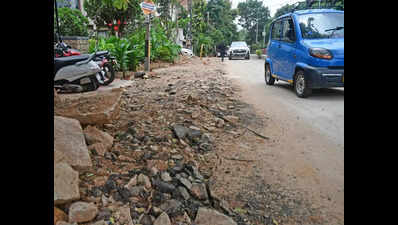Bengaluru’s dubious feat: No room for feet | Bengaluru News

Bengaluru: In India’s startup capital, footpaths appear to be rarer than unicorns! The city may boast of a 14,000km-long road network — including arterial, sub-arterial, major, and TenderSure roads — but the provision for pedestrians is minimal.Take arterial and sub-arterial roads, for example. Bengaluru has 1,671km of them, yet footpaths exist along just 2.9km. That works out to roughly 17cm of footpath for every 100 metres of road — about the length of a school pencil. The gap isn’t just statistical; it puts millions of people in harm, forcing them to walk in traffic.TenderSure roads, designed with pedestrian needs in mind, do better. They have footpaths throughout — but cover only 13.4km in total. As for the rest of the city’s roads, BBMP admits it has no data on footpaths. On the ground, it’s evident: In most areas, footpaths are either missing or unusable.The stark statistics for the arterial and sub-arterial network — from BBMP’s road infrastructure division covering 700 roads across all zones — also expose massive inconsistencies in development. While East zone has more than 1.2km of footpaths along 318km of roads, South zone fares poorly, with just 227 metres of footpaths across 231km of roads. Malathi Sathish, a septuagenarian who has lived in Jayanagar for over 40 years, said: “Earlier, we didn’t need footpaths because there wasn’t much traffic, but now things have changed. I love walking to the BDA complex at Jayanagar to pick up fresh vegetables and fruits, but there are no footpaths at all.”Fellow Jayanagar resident Anish Reddy echoed the frustration: “It’s absurd that newly built roads don’t come with basic walkability provisions. This shows systemic neglect, and in many cases, the footpaths are broken.”Even the relatively better-performing East zone, leading the city, faces significant challenges. For instance, in KR Pura, there’s only 29.4 metres of footpath for a road network of 83km. “Indiranagar and CV Raman Nagar have decent footpaths on both sides of the road,” said resident Preethi Muralidharan. “But here, encroachments and uneven tiles make walking unsafe.” But major areas such as TC Palya and Old Madras Road barely have space for pedestrians, pointed out Lakshmi Narayan, a retired schoolteacher and KR Pura resident. Perhaps most concerning is the planning for future infrastructure. Data reveals that for the proposed 272.4km of new road length, there’s just 594 metres of designated footpath space.“Where does the money go? Why are there no proper footpaths? Even in places such as Lavelle Road, the footpaths are in bad shape,” said Vinod Jacob of Namma Bengaluru Foundation. Senior BBMP road infrastructure officials acknowledged the crisis. “There is a lack of data on how many stretches don’t have footpaths, and honestly, there are no footpaths in many parts because of a lack of funds to build them,” an official said.LEARNING FROM GLOBAL CITIESCities worldwide demonstrate that proper planning and enforcement can transform pedestrian infrastructure through dedicated policies and sustained investmentNew York City: Sidewalks at least 1.5m wide, extending up to 4.5m, with designated areas for furniture, walking and building frontage following disability requirements.Barcelona: Streets feature sidewalks measuring 2.4m to 6m, extending to 10m on major roads through the Superblocks strategy that returns street space to pedestrians.Tokyo: Specially designed intersections and seamless public transport integration ensure both walkability and efficiency throughout the metropolitan area.Copenhagen: Since the 1960s, it has led pedestrian infrastructure development with dedicated pedestrian zones and extensive cycling lanes integrated into urban planning.Singapore: Comprehensive pedestrian infrastructure extends to Metro station exits, with clear wayfinding and consistent accessibility standards across the city-state.Mexico City: Implementing Norma Official Mexicana-004 standards and embracing tactical urbanism & complete streets principles to create pedestrian and cycling-friendly environments.PEDESTRIAN INFRA CRITICALPedestrian infrastructure remains overlooked in Indian urban planning despite millions relying on walking for daily transport, particularly the poor, elderly, and students.Safety crisis: IIT Delhi reported in 2016 that over half the road deaths in Indian cities involved pedestrians, cyclists, and two-wheeler riders. The National Crime Records Bureau revealed 15,000 pedestrian fatalities in 2021 alone.Bengaluru’s toll: 247 in 2022; 292 in 2023; 246 in 2024; and 71 deaths in 2025 so far.Infra solutions: Proper footpaths separate pedestrians from vehicles, improve accessibility, and encourage walking. Research by CEPT University shows adequate footpaths are essential for public transport connectivity.Health benefits: Walkable areas reduce pollution and improve public health. Investment in improved footpaths in Chennai and Pune increased pedestrian usage significantly.Policy response: Joint commissioner of police MN Anucheth cited measures, including high-rise medians from Rajkumar Samadhi to CMT Junction, pedestrian guard rails, and mapping accident-prone areas, for targeted intervention.WHAT CITIZENS SAYA city with good accessible network of footpaths directly impacts the health of its residents. Footpaths aren’t a luxury in urban planning, they’re imperative for people to sustainably experience their city with pride. With several cities across the globe going vehicle-free, it’s time Bengaluru put its citizen’s health and safety as priority and focused on building & maintaining safe, accessible footpaths for all— Swarna Venkataraman, I Change IndiranagarFootpaths should ensure safe transit, but today they’re riddled with hazards — broken slabs, parked vehicles, dangling cables, foul gutters, illegal stalls, and waste. Neglect, apathy, and lack of civic enforcement have turned them into danger zones, exposing a system unwilling to uphold basic urban discipline or instil the fear of consequences— Anilkumar J ,Jalahalli residentFootpaths tell a tale of irony — built for pedestrians, claimed by encroachments. Often broken, encroached, or missing, they challenge pedestrians. True progress isn’t in flyovers or expressways, but in safe, accessible sidewalks. A walkable city begins with respecting its footpaths. A truly progressive city is one where its weakest — children, the elderly, the differently-abled — can walk freely— Dhivya Kiran Jeevan, communications professionalIn Malleswaram, seniors navigate more potholes than pathways — it’s not a walk, it’s an obstacle course. If Bengaluru were a product, this would be a failed user journey for people who need it most. My 75-year-old neighbour shouldn’t have to choose between safety and a simple walk to the market. We talk about last-mile delivery, but forget the last-metre walk — KN Ranganath, product consultant
















